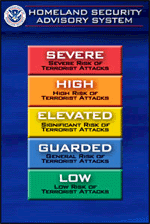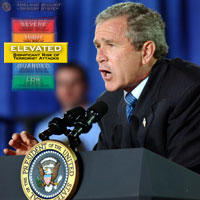 Brian Massumi writes about the US Department of Homeland Security's "terror alert system":
Brian Massumi writes about the US Department of Homeland Security's "terror alert system":Life has restlessly settled, to all appearances permanently, on the redward end of the spectrum, the blue-greens of tranquility a thing of the past. "Safe" doesn't even merit a hue. Safe, it would seem, has fallen off the spectrum of perception. Insecurity, the spectrum says, is the new normal. ("Fear (The Spectrum Said)" positions 13.1 [Spring 2005]: 31)The Proudfully American Logo Museum (a site that's well worth browsing) has a fine collection of threat logos. Here's one that shines out for its dynamism:

And it is our dynamic response to terror that, Massumi argues, the alert system seeks to calibrate and modulate:
The alert system was introduced to calibrate the public's anxiety. In the aftermath of 9/11, the public's fearfulness had tended to swing out of control in response to dramatic, but maddeningly vague, government warnings of an impending follow-up attack. The alert system was designed to modulate that fear. It could raise it a pitch, then lower it before it became too intense, or even worse, before habituation dampened response. Timing was everything. Less fear itself than fear fatigue became an issue of public concern. Affective modulation of the populace was now an official, central function of an increasingly time-sensitive government. (32)Moreover, and like the other logos that are always at the edge of the screen, glimpsed out of the corner of an eye, this colour-coded alert system is aimed not at consciousness, but at "bodies at the level of their dispositions toward action [. . .] The system addressed the population immediately, at a presubjective level" (32, 33).
Television here takes on a new function, to become "the event medium," distinguishing itself from the Internet though its "resurgent role as the privileged channel for collective affect modulation" (33). Bush's is a televisual mode of governance, which takes advantage of the way in which TV hotwires a link between image and affect, bypassing persuasion or proof, conducting collective resonance or what Massumi terms "attunement" (32). As we tune in, so we are also attuned to the prevailing "affective tone or mood" (41), a modulated fear before an unknown future threat.
Massumi goes on to develop a sophisticated and complex account of what we could term the vicissitudes of fear in these post-9/11 times.
This account is too involved to detail at length here. Those who have access to Project Muse can download the whole article, and indeed the entire issue of positions, which includes a number of related articles such as Alberto Moreiras's "Preemptive Manhunt: A New Partnership" and Marilyn Young's "Permanent War."
It's interesting, however, that Massumi's argument seems to reverse his position in the much-reproduced and collected article "The Autonomy of Affect" (which ended up as the first chapter of Parables for the Virtual). There, Massumi's stress is on affect's ontological priority, "its participation in the virtual," but also the way in which "it escapes confinement in the particular body whose vitality, or potential for interaction, it is" (Parables for the Virtual 35). Affect in this sense is a figure of resistance, and also of constituent power: "Something has always and again escaped. [. . .] Actually existing, structured things live in and through that which escapes them. Their autonomy is the autonomy of affect" (35).
Here, in "Fear (The Spectrum Said)," however, Massumi emphasizes the initial co-presence, immanence or immediacy, of affect and action, the way in which "we have already begun to experience fear nonconsciously, wrapped in action, before it unfurls from it and is felt as itself, in its distinction from the action with which it arose" (36); it is only subsequently, "as the action unfolds" that "the affect of fear and the action of the body [. . .] begin to diverge" (37). Linearity (narrative) separates itself out from the nonlinear intensity of affect, and then recodes (reflects upon and recollects) that affect as, now, quantifiable emotion.
Massumi continues by tracing "the autonomization of fear" as, simultaneously, "a next natural step" (42; my emphasis) in a series of feedback loops ("from activation to feeling-in-action, from feeling-in-action to pure expression of affect, from pure expression of affect to branchings into perception, reflection, and recollection, then on to affective containment" [44-45]), and at the same time a politically-motivated mechanism of control that leads us eventually to "the wonderland world where the startle can come without the scare: body activation without the feeling [. . .] that it is" (44; emphasis in original).
So, two comments (and I suspect they're related):
First, I'm not sure about this new topography of affect that Massumi presents here. Or rather, it's not so much that the topography is itself new but that the conclusions drawn are very different. It almost sounds like a lament for the ways in which affect diverges from action through time, whereas "The Autonomy of Affect" had presented precisely that divergence (the fact that "something has always and again escaped") as the very possibility of minoritarian empowerment.
Second, Massumi comes close, in presenting this series of "loops" as quasi-natural consequences of any shock to the system, to legitimating contemporary forms of power as simply the complex effects of unfolding immanent processes. This reminds me of the way in which Manuel de Landa eviscerates Deleuze and Guattari's work of any political charge, by posing complexity theory as immanent justification for the world as it is.
I know that Massumi doesn't want to leave us with this second conclusion, and to be fair I am sure that this article is simply part of a larger work in progress. But here at least the only gesture towards resistance or counter-power is, well, no more than gestural, coming in this piece's one-sentence final paragraph, which reads in full:
Confusingly, it is likely that [the Bush administration's fear in-action] can only be fought on the same affective, ontogenetic ground on which it itself operates. (47)My own suspicion, then, is that some kind of counter-power only finds a place here as a residual "confusing[. . .] likel[ihood]" precisely because the main force of the article has been to argue that "all that is certain is that fear itself will continue becoming--the way of life" (47). Which is surely a resigned pessimism of the intellect if anything is.
No comments:
Post a Comment